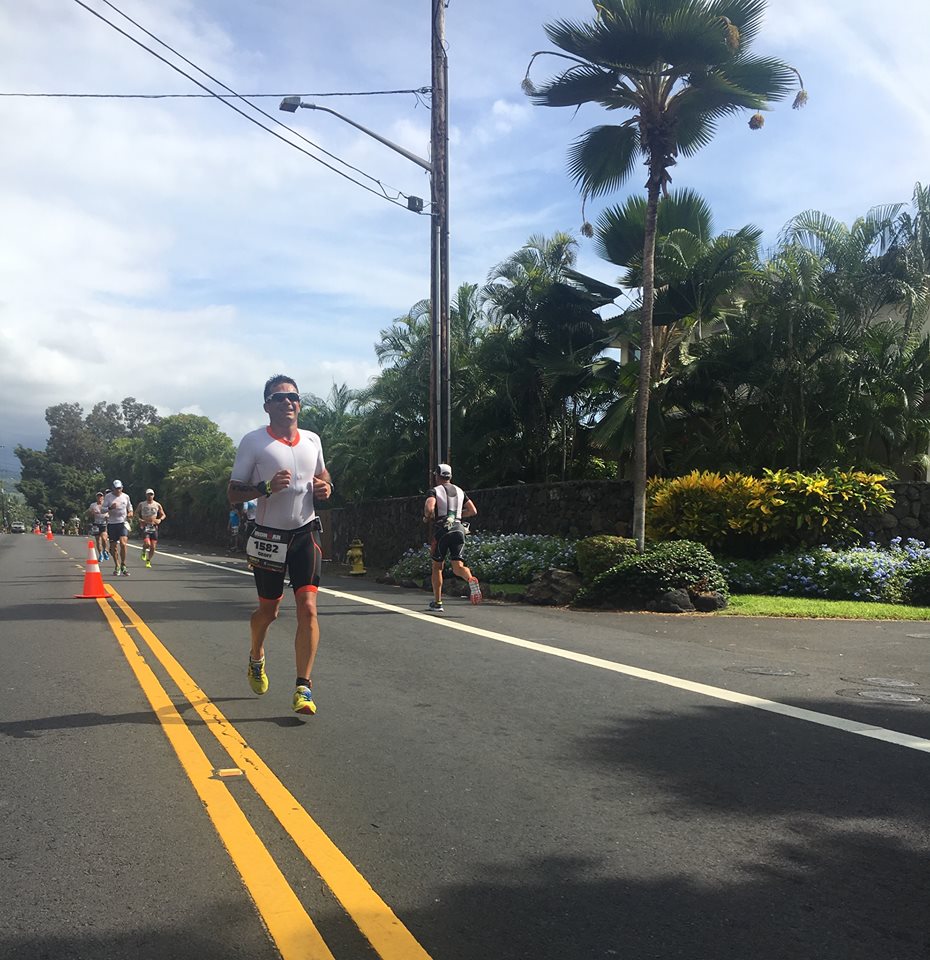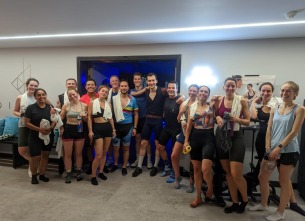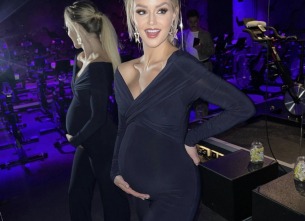My preparation for the Ironman World Championship was not exactly ideal, given that in the few months leading up to the race my wife Caoimhe and I launched a new business and had our second son, Ben, but I was very happy with how it turned out. Here's a blow by blow account of event day...
Pre-race nutrition
Night before – pasta with chicken and tomato and basil sauce. Not spicy.
Morning – small bowl of low-fibre granola with skimmed milk, and slice of toast with crunchy peanut butter. 700ml ironman perform sipped up to 30 mins pre-start.
Swim – 1:11:39
The swim was rough as always and I got beaten up a fair bit at the start including one quite sharp kick to the face. I managed to deal with the shock and panic and just focussed on getting my breathing and heart rate back under control.
I started wide on the left, but the general trajectory of the field was pretty much straight toward the first buoy, which slightly eased the crush. I tried to settle on to a couple of different swimmers’ feet, with some limited success.
My main mistake was coming back into the pier when I just swam too wide into the beach. I probably lost a good 30 seconds here.
T1 – 4:03
Nutrition – cup of Gatorade
I got stitched up by my transition assistant when he put my HR strap on upside down and couldn’t seem to get my race suit on to my arm. Retrospectively, I should have just put this over my shoulders while running to the bike.
Getting out of T1 is always slow for me at Kona as it’s a logjam with athletes and we’re all backed up just to get to the mount line. I probably lost 30 seconds with the suit/HR strap situation but beyond that there’s not a great deal I could have done to go faster.
Bike – 5:25:32
Nutrition: Gatorade (80%+ of fluid intake), gels in water bottle (with small bit of water added), water (10-15% of fluids), salt.
When I got on the bike, my HR was very elevated – around 169bpm. As such, I tried to pedal gently for the first few miles to get it back down around the 150 level. I struggled to do so for some time, although I was feeling comfortable. As I turned on to the Queen K to head out to Hawi, I made the decision to try to keep it averaging under 160 – about 10 beats higher than I wanted, but something that I should be able to manage for the distance assuming the power/HR relationship I was seeing was maintained.
The first half of the bike was extremely frustrating. I found myself stuck in a group of extremely ill-disciplined athletes. The guys seemed to be happy to draft liberally, overtake on the right or behave dangerously at aid stations. The most frustrating aspect of this was I was unable to really maintain race power. If I pushed my race watts, I’d go to the front of the group but not get away as people would sit on my wheel. Invariably, then someone would end up coming past and pulling in on my front wheel, forcing me to back off, at which point the next drafting athlete would pull into the gap created by me.
As such, I was forced into the very irritating choice of either having to ride other people’s pace or push hard to get away and risk blowing up in the second half. I chose to try to keep the pace under control and just try to avoid being caught up in any dodgy riding.
I felt pretty good all the way up to Hawi as I rode at a conservative power, even if my HR didn’t come down significantly. We had some nasty headwinds in the section up to Kawaihae, so the average speed dropped a fair bit. I tried to just focus on getting on board regular salt, gels and Gatorade to make sure the legs were kept fresh for the return journey.
Once we made the turn up at Hawi, gaps started opening in the field as the impact of the climb up to Hawi took its toll on the legs and the weaker riders started to fade. I was delighted to see this and pushed – possibly a little harder than I should have – on the downhill stretch to open up some space and get away properly.
I was feeling good as I came over the climb coming out of Kawaihae and started the push for home. The winds had turned around so we had a headwind in both directions. This section can be very tough on the mind as it is hot, windy, you’ve got 70 miles in your legs already and you’ve still got a good 90 minutes back to T2. However, having ridden this twice in training I knew the road well and was prepared.
I was feeling good for the first five miles on the Queen K and then my rear inner tube blew. This was a huge blow as I knew I’d made good progress on the field since Hawi and with this I’d be right back in the bunch. However, I tried to just focus on getting a swift change done and re-mounting the bike. I got the inner tube replaced fairly fast, but struggled to get the tyre back on the wheel. After a minute or so struggling with this, tech support arrived and took the wheel from me. They got me back up and running fairly quickly and, all in, I ended up losing about six minutes. Not helpful, but not a complete disaster.
I got back into the field and started regaining time. It’s very frustrating overtaking faces you thought you’d left behind, but with each athlete I went past I felt better about myself.
The splits on the bike tell the numerical story of the narrative above. I gained 11 places in my age group (from 200th to 189th) in the 59 miles up to Hawi and gained 13 places (176th) by the end of the bike, despite the puncture. I lost six places in the age group in the 12-mile time split in which I punctured.
Coming into T2, I’d talked a lot with Alan about the importance of feeling fresh so I tried to make sure I kept my HR down in the last few miles. It is always so tempting to hammer the last few miles as the adrenaline picks up in anticipation of finishing the bike leg. I managed to control this urge fairly well, knowing that for me, in Kona, the run is my opportunity to make up time.
T2 – 2:59
I like to keep my transitions simple and free from unnecessary distractions. My T2 bag contains just sunglasses, trainers and socks. No hat choices, no extra nutrition etc. I ran quickly through T2 and was excited to hit the run. I spotted the time on the race clock as 6:41 as I came into T2 and I knew that a PB was going to require a fast run after the puncture.
Run – 3:14:44
Nutrition: Gatorade, Coke, ice and water every now and then.
Starting the run, I knew something wasn’t right immediately. I’d been struggling with calf pain for the entire fortnight in Kona. I think this was related to some hip pain I’d been experiencing in the build to Kona, which itself was caused by carrying my boys around more in recent weeks (since Ben was born).
My calf felt extremely tight right from the start, which meant I couldn’t elongate my stride and had to drive with emphasis from the quad. I increased my cadence to compensate and I was very nervous that the leg wasn’t going to hold up for the whole run.
I tried to just take each mile as it came and not think too much about the total distance. I was really happy to see my wife Caoimhe on the run. She is amazing at getting about to support in these races and knowing she was going to be there was a real boost.
My first mile was 7:08 and it felt easy enough, but my HR pushed up through 165 and I knew this was too much too soon, even if I did feel okay (aside from the calf). I dialled it back a touch. Again, my HR was a bit on the high side but I felt good and 160 bpm seemed to give me a sustainable pace. I made a mental note to try to keep my HR below 165 but not much below 160 for the run.
I stuck to this for pretty much the duration of the 26 miles, with the exception of going up Palani (knowing that the next 1km was downhill) and then from Mark & Dave Hill to the finish. Thankfully, although the calf was painful for the entire run, with the changes to my stride it didn’t seem to get a lot worse.
I came past old friend and training partner Martin Muldoon after coming out of the energy lab. I was really sad to see him struggling with an injury after a crash on the bike. He’s said all year this would be his last Kona and I was gutted to see his race go this way. Being the sport he is, he gave me a good cheer and butt-slap as I came past, but it gave me no joy to pass him. He’s a ferocious competitor and I had no doubt he’d make it to the finish line, but I’m sad for him some bad luck affected his race.
I was very emotional as I turned down Palani to come back into town. The last four months have been a complete blur and the busiest of my life. I thought of all of the hours I’d sacrificed (sorry to my poor wife Caoimhe and my family and friends whom I’ve barely seen in the last few months). I thought of the fact it had been six years since I put together a good Ironman. I thought of the family who had travelled to the most remote island chain in the world on the opposite side of the globe to support me in a frankly absurd pursuit – thanks guys. I thought of my dad, who I know would have loved nothing more than to be in Kona were it not for his health.
Finish – 9:58:57
I sprinted for the line, not knowing exactly when the gun had gone off and how much time I had to spare to break 10 hours. It was only in the last 50 metres or so that I could see the times coming up on the race clock that I knew I had a sub-10 in the bag.
With my run, I’d pinched 77 places from the end of the bike and finished 99th in my age group. Top 100 in the world. That’ll do.
Obviously, I’m gutted not to have beaten my PB, which was set in Kona six years ago and remains 9:55:55. Were it not for the puncture, I would have done, which makes it all the more annoying.
That said, I swam three minutes faster, I ran 10 minutes faster and the bike was windier in 2016 than 2010 so I’m pretty sure overall this performance was stronger. Indeed, if I adjust for the puncture I would have finished around 370th overall vs 400th in 2010. Given the improvement in the age group field since 2010, this is very pleasing.
I feel I am capable of more, I know I am capable of more. That said, this was the very best I had on the day when all factors are considered. My race was well executed – I didn’t really have any really weak patches, I had no cramping, my heart rate was pretty static throughout the day. Sure, I could have nicked a couple of minutes here and there, but Kona 2016 is the first race I can say I pretty much executed close to my ability from gun to tape. As disappointing as missing the PB is, you can only control the controllables and I pretty much did that all day. I’m proud of that, but my coach Alan Couzens deserves a lot of the credit too. Nice one, AC.
As ever, many thanks to everyone who has been part of the journey. Special mentions must go to: Alan – for all the guidance on strategy, pacing and all the sessions; Martin – for all the training rides, tips and inspiration, you’re a legend mate; most of all though, Caoimhe – for putting up with the long rides, runs, post-training exhaustion grumps and terribly boring CTL chat. You’re my rock and I love you.








COMMENTS (0)
Be the first to comment!
Please login to comment